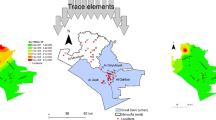Abstract
A regional air assessment was performed to characterize volatile natural isothiocyanate (NITC) compounds in air during soil incorporation of mustard cover crops in Washington State. Field air sampling and analytical methods were developed specific to three NITCs known to be present in air at appreciable concentrations during/after field incorporation. The maximum observed concentrations in air for the allyl, benzyl, and phenethyl isothiocyanates were respectively 188, 6.1, and 0.7 μg m−3 during mustard incorporation. Based on limited inhalation toxicity information, airborne NITC concentrations did not appear to pose an acute human inhalation exposure concern to field operators and bystanders.

Similar content being viewed by others
References
Bending GD, Lincoln SD (1999) Characterization of volatile sulphur-containing compounds produced during decomposition of Brassica juncea tissues in soil. Soil Biol Biochem 31:695–703
Bhat RG, Subbarao KV (2001) Reaction of broccoli to isolates of Verticillium dahliae from various hosts. Plant Dis 85:141–146
Bones AM, Rossiter JT (1996) The myrosinase-glucosinolate systems–its organization and biochemistry. Physilogia Plantarium 97:194–208
Boublik T, Fried V, and Hala E, (1984) The vapor pressures of pure substances. 2nd edn. Elsevier, Amsterdam, p.232
Brown PD, Morra MJ (1997) Control of soil-borne plant pests using glucosinolate-containing plants. Adv Agron 61:167–231
California Department of Pesticide Regulation (1994) Air monitoring for methylisothiocyanate during a sprinkler application of metam-sodium. California Department of Pesticide Regulations Report EH 94-02
Davis JR, Huisman OC, Westerman DT, Hafez SL, Everson DO, Sorensen LH, Schneider AT (1996) Effects of green manures on Verticillium wilt of potato. Phytopathology 86:444–453
Department of Energy (2008) Department of Energy Subcommittee on Consequence Assessment and Preparedness Activities, Pac-TEEL database, found on: http://www.atlintl.com/DOE/teels/teel/result.asp. Accessed 29 July 2011
Fahey JW, Zalcmann AT, Talalay P (2001) The chemical diversity and distribution of glucosinolates and isothiocyanates among plants. Phytochemistry 56:5–51
Fenwick GR, Heaney RK, Mullin WJ (1982) Glucosinolates and their breakdown products in foods and plants. CRC Crit Rev Food Sci Nutr 18:123–201
Kirkegaard JA, Sarwar M (1998) Biofumigation potential of Brassicas—I. Variation in glucosinolate profiles of diverse field-grown Brassicas. Plant Soil 201:71–89
Matthiessen JN, Kirkegaard JA (2006) Biofumigation and enhanced biodegradation: opportunity and challenge in soilborne pest and disease management. CRC Crit Rev Plant Sci 25:235–265
McGuire A (2003). Green manuring with mustard: improving an old technology. Agrichem and Environ News 206
Mithen RF (2001) Glucosinolates and their degradation products. Adv Bot Res 35:213–232
Ochiai N, Powelson ML, Dick RP, Crowe FJ (2007) Effects of green manure type and amendment rate on Verticillium wilt severity and yield of Russet Burbank potato. Plant Dis 91:400–406
Olivier C, Vaughn SF, Mizubiti EFG, Loria R (1999) Variation in allyl isothiocyanate production within Brassica species and correlation with fungicidal activity. J Chem Ecol 25:12
Rask L, Andreasson E, Ekbom B, Eriksson S, Pontoppidan B, Meijer J (2000) Myrosinase: gene family evolution and herbivore defense in Brassicaceae. Plant Mol Biol 42:93–113
Rosa EAS, Heaney RK, Fenwick GR, Portas CAM (1997) Glucosinolates in crop plants. Hortic Rev 99:215
Smolinska U, Horbowicz M (1999) Fungicidal activity of volatiles from selected cruciferous plants against resting propagules of soil-borne fungal pathogens. J Phytopathol 147:119–124
Author information
Authors and Affiliations
Corresponding author
Rights and permissions
About this article
Cite this article
Trott, D., LePage, J. & Hebert, V.R. Assessing Natural Isothiocyanate Air Emissions after Field Incorporation of Mustard Cover Crop. Bull Environ Contam Toxicol 88, 482–485 (2012). https://doi.org/10.1007/s00128-011-0506-6
Received:
Accepted:
Published:
Issue Date:
DOI: https://doi.org/10.1007/s00128-011-0506-6




